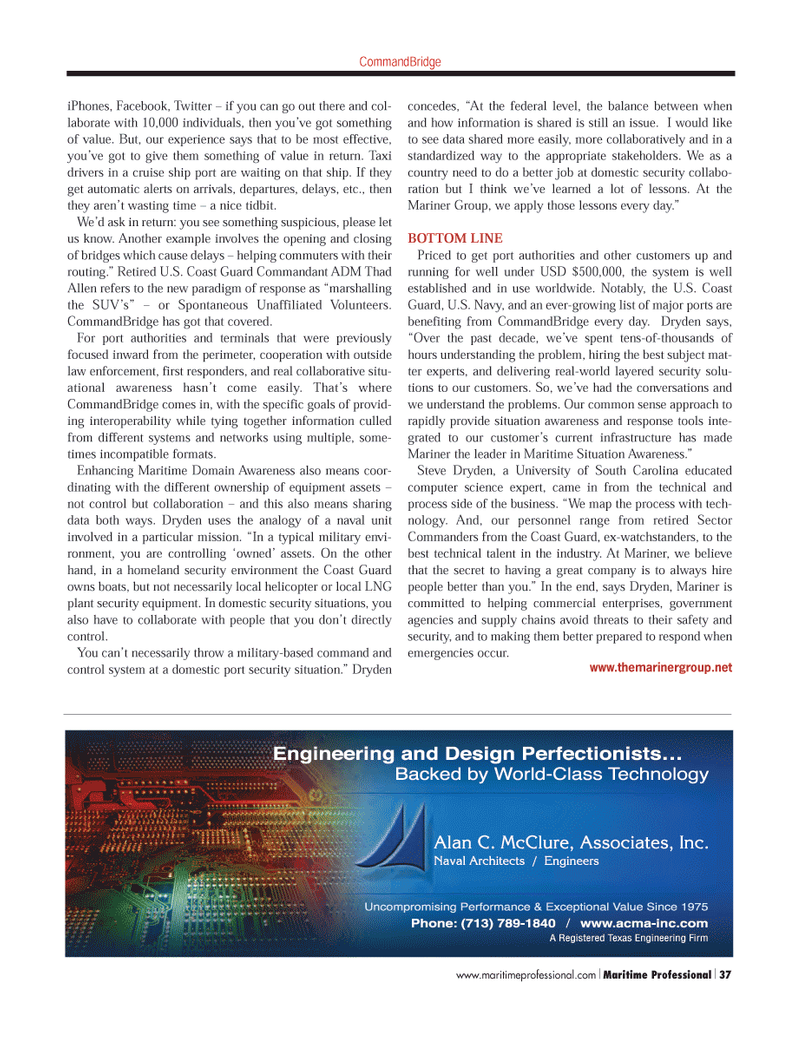
Page 37: of Maritime Logistics Professional Magazine (Q3 2011)
Maritime Security / Maritime Training & Education
Read this page in Pdf, Flash or Html5 edition of Q3 2011 Maritime Logistics Professional Magazine
www.maritimeprofessional.com Maritime Professional 37 iPhones, Facebook, Twitter ? if you can go out there and col- laborate with 10,000 individuals, then you?ve got something of value. But, our experience says that to be most effective, you?ve got to give them something of value in return. Taxi drivers in a cruise ship port are waiting on that ship. If they get automatic alerts on arrivals, departures, delays, etc., then they aren?t wasting time ? a nice tidbit. We?d ask in return: you see something suspicious, please let us know. Another example involves the opening and closing of bridges which cause delays ? helping commuters with theirrouting.? Retired U.S. Coast Guard Commandant ADM Thad Allen refers to the new paradigm of response as ?marshalling the SUV?s? ? or Spontaneous Unaffiliated Volunteers. CommandBridge has got that covered. For port authorities and terminals that were previously focused inward from the perimeter, cooperation with outside law enforcement, first responders, and real collaborative situ- ational awareness hasn?t come easily. That?s where CommandBridge comes in, with the specific goals of provid- ing interoperability while tying together information culledfrom different systems and networks using multiple, some- times incompatible formats.Enhancing Maritime Domain Awareness also means coor- dinating with the different ownership of equipment assets ? not control but collaboration ? and this also means sharing data both ways. Dryden uses the analogy of a naval unit involved in a particular mission. ?In a typical military envi- ronment, you are controlling ?owned? assets. On the other hand, in a homeland security environment the Coast Guard owns boats, but not necessarily local helicopter or local LNG plant security equipment. In domestic security situations, youalso have to collaborate with people that you don?t directly control. You can?t necessarily throw a military-based command and control system at a domestic port security situation.? Dryden concedes, ?At the federal level, the balance between when and how information is shared is still an issue. I would like to see data shared more easily, more collaboratively and in a standardized way to the appropriate stakeholders. We as a country need to do a better job at domestic security collabo-ration but I think we?ve learned a lot of lessons. At the Mariner Group, we apply those lessons every day.? BOTTOM LINE Priced to get port authorities and other customers up andrunning for well under USD $500,000, the system is wellestablished and in use worldwide. Notably, the U.S. Coast Guard, U.S. Navy, and an ever-growing list of major ports are benefiting from CommandBridge every day. Dryden says, ?Over the past decade, we?ve spent tens-of-thousands of hours understanding the problem, hiring the best subject mat-ter experts, and delivering real-world layered security solu- tions to our customers. So, we?ve had the conversations and we understand the problems. Our common sense approach torapidly provide situation awareness and response tools inte- grated to our customer?s current infrastructure has made Mariner the leader in Maritime Situation Awareness.? Steve Dryden, a University of South Carolina educated computer science expert, came in from the technical and process side of the business. ?We map the process with tech- nology. And, our personnel range from retired Sector Commanders from the Coast Guard, ex-watchstanders, to the best technical talent in the industry. At Mariner, we believe that the secret to having a great company is to always hire people better than you.? In the end, says Dryden, Mariner is committed to helping commercial enterprises, government agencies and supply chains avoid threats to their safety and security, and to making them better prepared to respond when emergencies occur. www.themarinergroup.net CommandBridge MP #3 (34-49):MP Layouts 8/17/2011 4:22 PM Page 37

 36
36

 38
38
